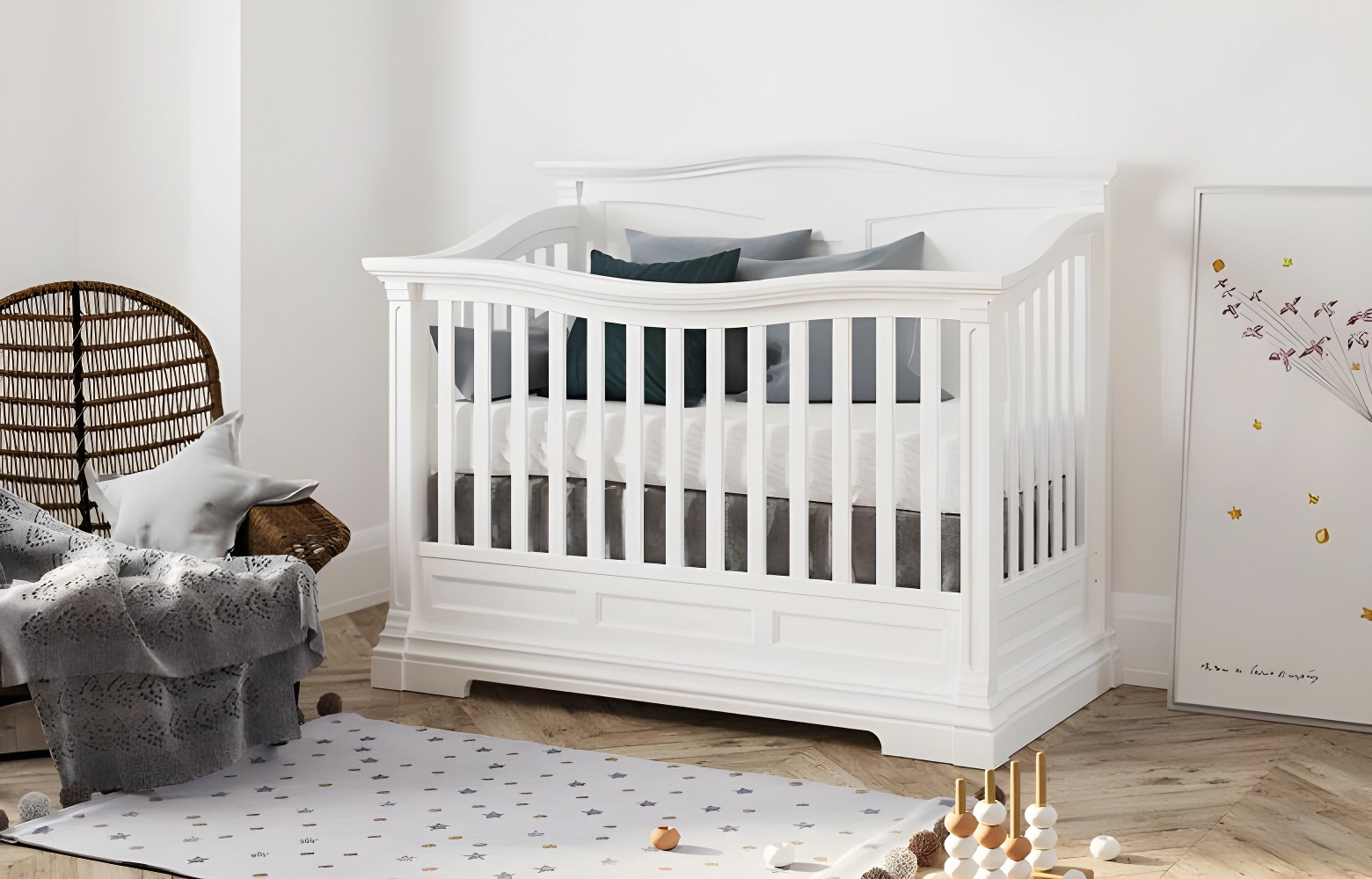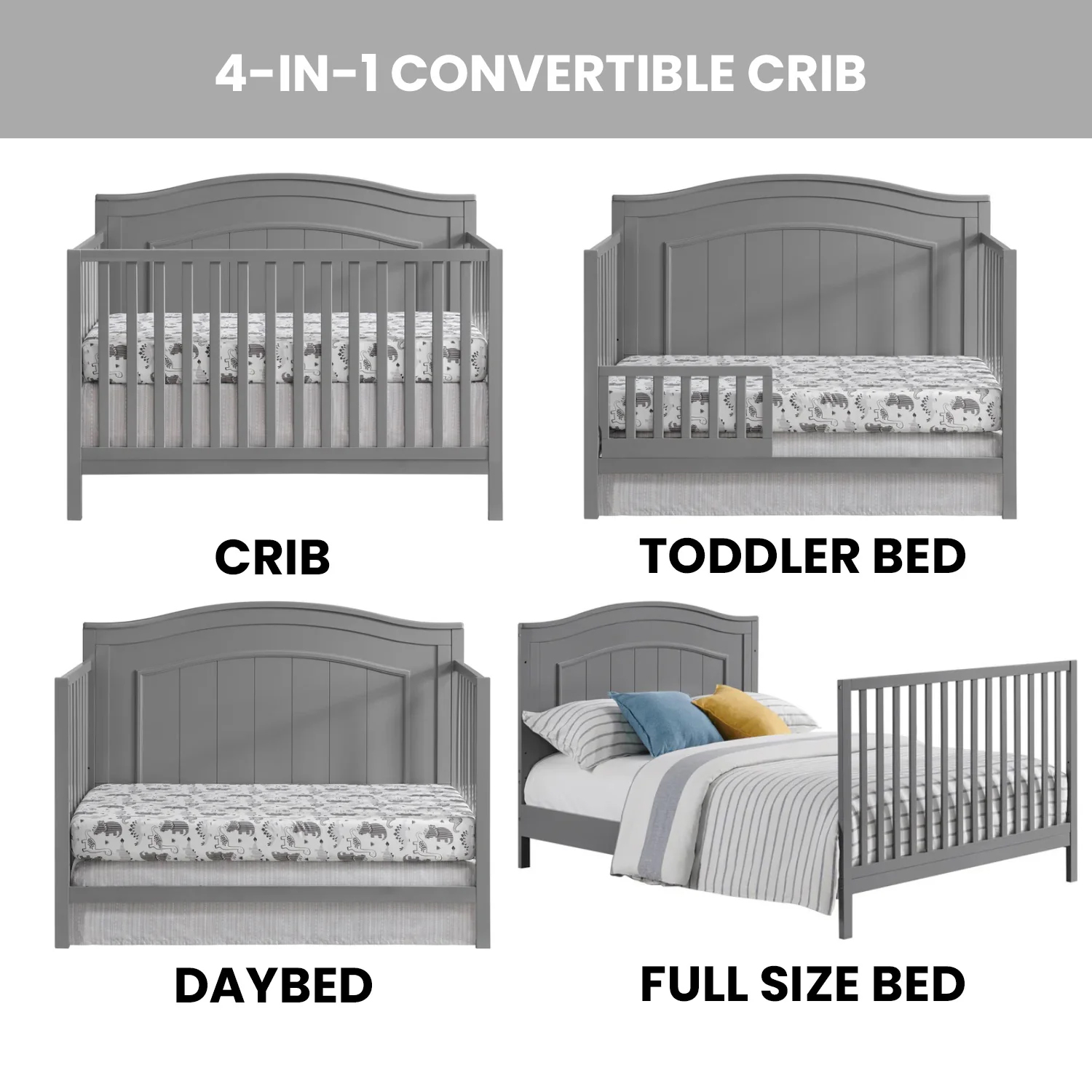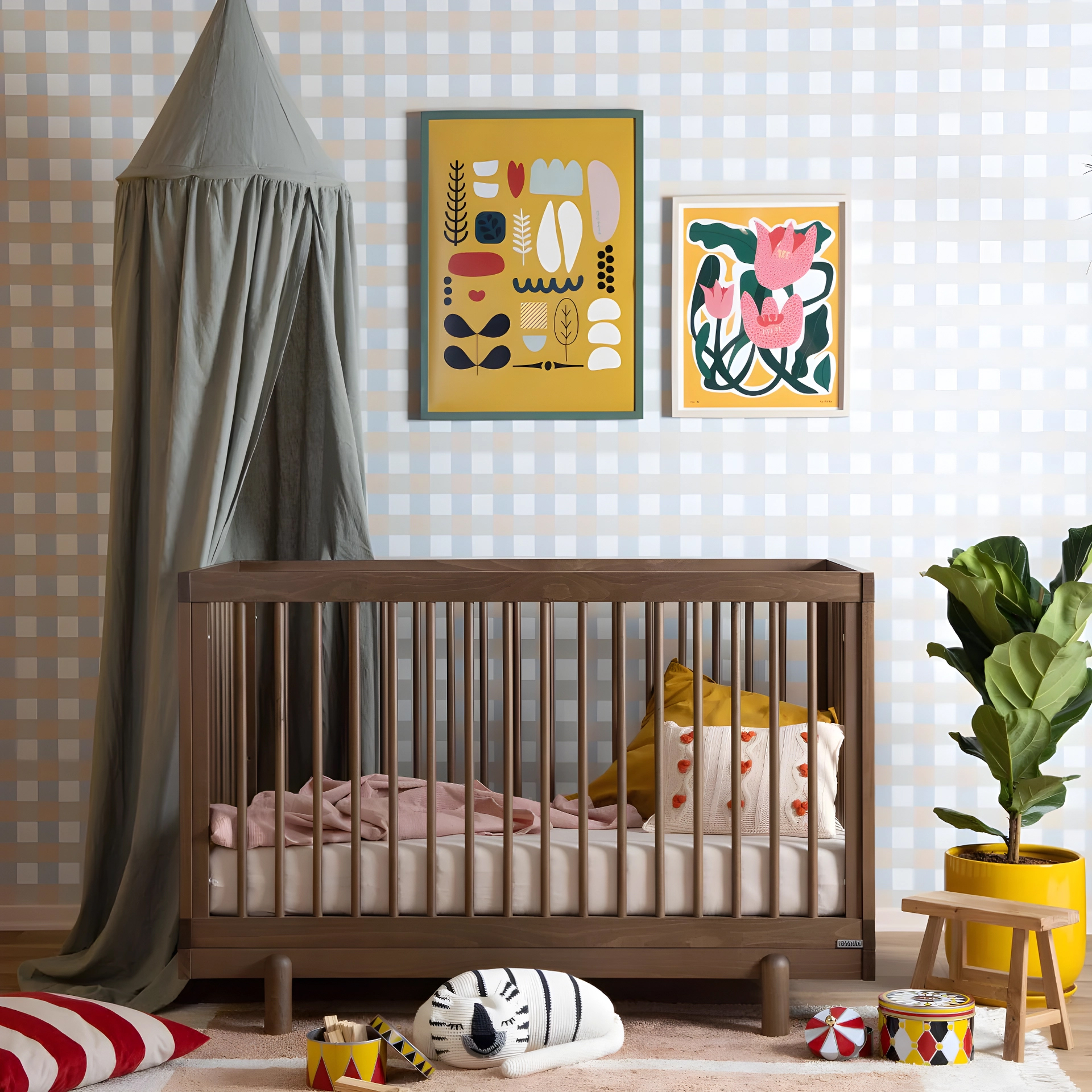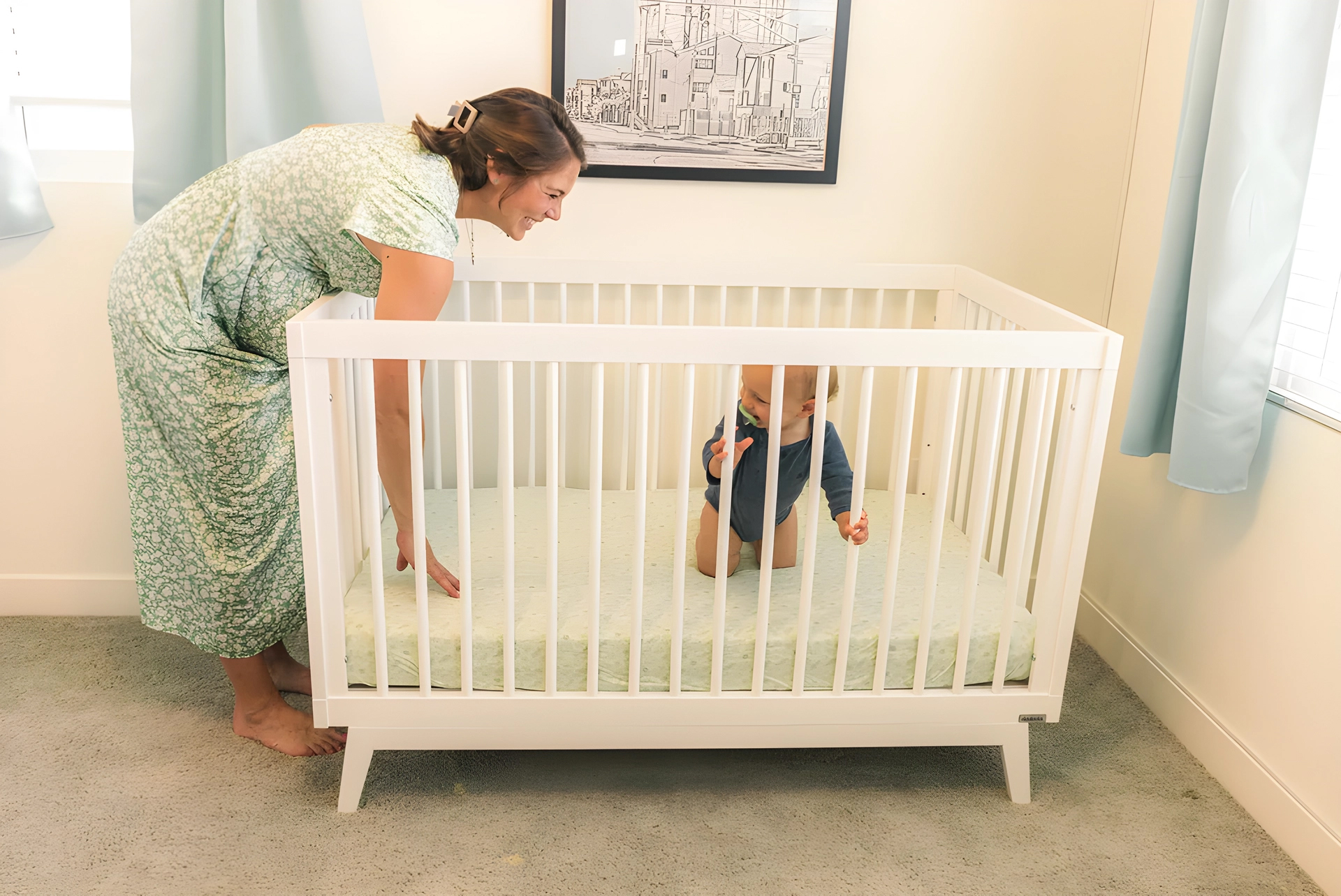
A Fresh Start in Baby Furniture
There’s something deeply symbolic about setting up a nursery. It’s not just about furniture or aesthetics — it’s about preparing for a new life that’s about to turn your world upside down in the best (and most sleep-deprived) way possible. And right at the center of that nursery stands the crib. It’s the place where your baby will spend most of their early months — sleeping, dreaming, and sometimes refusing to sleep at all.
For many parents, choosing a convertible crib feels like a smart, forward-thinking move. After all, who wants to buy four different beds over five years? A crib that becomes a toddler bed, then a daybed, and eventually a full-size bed sounds like the most practical decision in a sea of baby purchases that are often used for only a few months.
I remember helping a couple in Lviv set up their first nursery. They had a tiny room and a modest budget, and they were anxious about getting it all “right.” When I suggested a 3-in-1 crib, they were skeptical at first — it cost a bit more upfront. But a few months later, the dad sent me a photo of their son sleeping peacefully, curled up in the toddler bed configuration. He wrote:
I didn’t think we needed anything fancy. But now I see the crib wasn’t about luxury — it was about consistency. It’s been with us through teething, sleep regressions, and growth spurts. It’s the only bed he’s ever known.
That kind of familiarity can mean everything, especially in the whirlwind of early parenthood. Babies thrive on routine, and having a consistent sleep space — one that doesn’t dramatically change in size or shape — can help foster better sleep habits from the start.
But more than that, it’s about emotional continuity. A crib that transforms over the years can carry family memories with it: the first night home from the hospital, the first night your baby slept through, the first night they climbed out on their own. You’re not just investing in wood and screws — you’re investing in a witness to childhood.
That’s the part that rarely makes it into product descriptions. But it matters. When your baby’s first bed becomes their reading nook at age four, or a cozy spot for bedtime chats years later, you’ll understand the quiet power of that simple choice.
Decoding the Labels: 2‑in‑1, 3‑in‑1, 4‑in‑1— and Beyond
Let’s clear something up right away: those catchy “in‑1” labels you see on convertible cribs? They’re marketing terms — not standardized categories. You could look at five different cribs labeled “3-in-1” and walk away with five completely different setups, requirements, and expectations. The numbers are vague, and most brands don’t bother to explain what they really mean unless you dig into the fine print.

In theory, here’s what the numbers usually refer to:
- 2-in-1: Starts as a crib, later converts to a toddler bed.
- 3-in-1: Crib → toddler bed → daybed (or sometimes toddler bed with rails → toddler bed without rails).
- 4-in-1: Crib → toddler bed → daybed → full-size bed with headboard/footboard.
But in practice, the lines blur. For example, some 4-in-1 cribs don’t include conversion kits — they’re optional, and sometimes sold by third-party vendors. I once consulted a mom who ordered what she thought was a complete 4-in-1 package. It arrived in three boxes, only to find the full-size bed rails weren’t included. Worse: they were out of stock from the manufacturer.
The “4-in-1” label gave me a false sense of security. I thought we were set for years, but instead, we were scrambling for parts after 18 months.
And then there are the hybrid cribs that claim to be “5-in-1” or even “8-in-1.” Sounds impressive, right? Until you realize some of the “modes” are things like turning the toddler bed into a bench — or simply removing the guardrail and calling it a “new configuration.” Functionally, there’s little difference, but it helps justify a higher price tag.
Another thing that gets overlooked is what’s actually usable in your space. A family I worked with had a narrow bedroom and assumed they could set up the full-size version of their 4-in-1 crib by the time their daughter turned five. They didn’t consider how wide the frame would be or the fact that it didn’t fit through their hallway without being disassembled. The box might promise a “roomy full-size bed,” but your floor plan might disagree.
This is where it pays to ask the uncomfortable questions: What does each stage require in terms of tools and parts? Are those parts included? Can I find replacements if I need them three years from now? Do I actually want a full-size bed made from this crib’s headboard when my child is ten — or will I prefer to start fresh?
Buying a convertible crib is a bit like entering a long-term relationship. The first impression matters, yes — but you also need to know how things will hold up over time. And that means going beyond the label and looking at the reality behind the number.
What “Grows with Your Child” Looks Like Day to Day
If you’ve spent any time reading product descriptions for cribs, you’ve seen this line: “Grows with your child.” It sounds lovely. But it’s also vague. What exactly does it mean for a piece of furniture to “grow” with a baby who’s changing every week? What does it look like in real homes, on real mornings when you’re running on three hours of sleep and your toddler is refusing socks?
The idea behind this phrase is simple: the crib adapts to your child’s developmental stages. But children don’t grow in neat, predictable steps. One child might be pulling up and climbing by ten months, while another is still rolling over at twelve. Growth isn’t linear — it’s full of surprises. And furniture doesn’t grow at all; what really needs to grow is your ability to adapt that furniture to your child’s needs without turning every nap into a DIY project.
I remember working with a mom who planned every stage ahead of time — she had notes about when to lower the mattress, when to remove the front rail, when to convert to a toddler bed. But then her daughter refused the toddler bed altogether. She missed the enclosed feeling of her crib, and bedtime became a nightly meltdown. After a week of frustration, the mom put the rail back on and waited two more months. That’s what real growth looks like: not a schedule, but a response.
I thought she’d love the freedom of a toddler bed. Turns out, she loved the safety of the crib more. Once we slowed down, bedtime stopped being a battle.
Some kids breeze through transitions. Others cling to what they know. Having a convertible crib means you don’t need to rush the process. You can linger in each stage as long as it serves your child’s sense of security — and your sanity.

And then there’s the physical wear. As your child grows, their weight increases, their movements become more powerful, and their sense of ownership over space begins to bloom. I’ve seen toddlers turn a crib into a trampoline (not recommended), and preschoolers use the rails to hang their costumes like it’s a mini closet. A good convertible crib should hold up — not just structurally, but also in how it integrates into their ever-evolving world.
Think of “grows with your child” less as a technical feature and more as a mindset. It’s about staying flexible. It’s about recognizing when your child is ready — and when they’re not. It’s about having tools that respond to your family’s rhythm, not the other way around. The crib doesn’t do the growing. You do — together.
What the Ads Don’t Show
If you’ve ever browsed baby furniture catalogs, you know the look — soft pastel walls, sunlight streaming through gauzy curtains, and a crib so perfect it practically glows. The baby’s always asleep, the room’s always spotless, and the crib? Positioned with surgical precision in the middle of a room twice the size of your actual nursery.
But here’s what they don’t show you.
No one photographs the back of the crib — where screws are visible and the finish is already chipped after one assembly. No one tells you how heavy the frame is when you try to move it for the third time in one week because the only outlet in the room is behind the headboard. No one shows the layer of dust you’ll find underneath it once your baby starts crawling and you realize you haven’t vacuumed under there since birth.
One family I worked with had a gorgeous, high-end 4-in-1 crib. It looked stunning in their urban apartment… until they tried to convert it into a toddler bed. The conversion kit was sold separately, which they knew, but what they didn’t realize? It required a specific Allen key that wasn’t included — and was also not compatible with any universal ones. They spent two days emailing the manufacturer, only to discover the tool was discontinued.
The ads told us it would “seamlessly transition through childhood.” It did — but only if childhood includes borrowing power tools from your neighbor at 11 PM.
Another reality? Not all conversions are intuitive. Some require removing and reinstalling half the frame. Others have confusing instructions with grainy photocopied diagrams. A dad once told me it took him four hours, two energy drinks, and a YouTube video in Portuguese to convert his son’s crib into a daybed. And once it was done, the mattress no longer fit snugly — a safety concern that no one warned about.
Also missing from ads: the sheer scale. Full-size conversion often requires more space than most city apartments can offer. That “cozy” headboard becomes a wall-dominating slab of wood. I always recommend parents tape out floor dimensions before buying, especially for 4-in-1 models. A crib might look modest online, but assembled, it can make your nursery feel like a storage unit.
And don’t get me started on the finish. Many cribs boast “non-toxic paint,” which sounds reassuring — but after teething, you might notice little tooth marks in the rails. A mom I know said her daughter used the side of the crib “like a corn cob.” Beautiful furniture meets baby instincts.
So yes, convertible cribs are useful — but the ads leave out the dust, the dents, and the drama. That doesn’t mean they’re bad. It just means you deserve the full picture before clicking “Add to Cart.”
Making Each Transition Smooth
Here’s a guide to help you time and manage each conversion—no fluff, just real steps and lived advice:
From Bassinet to Crib
Around 4–6 months, or when your baby exceeds weight limits or starts rolling. A midwestern mom shared she moved her son when his feet touched the sides at night—he took to the crib immediately :contentReference[oaicite:2]{index=2}. Steps:
- Clear bedding, unscrew bassinet parts.
- Adjust mattress to highest position.
- Attach full crib frame securely. No gaps!
- Tighten every screw before bedtime.
Crib to Daybed
Typically around 15–24 months, especially if climbing starts. Often done when you’re not ready for a toddler bed but want more openness. Steps:
- Bring mattress to lowest height.
- Remove one long side.
- Ensure remaining sides are tight/secure.
- Add a cozy mattress and toss pillows.
Daybed to Toddler Bed
Between 18 months and 3 years—when climbing meets potty training. Guardrails help avoid falls. Steps:
- Remove pillows, lower mattress.
- Install toddler rails (sometimes extra cost).
- Test stability with adult pressure.
Toddler Bed to Full‑Size Bed
From 3 to 5 years, or when the toddler frame feels cramped. Space and space needs matter. Steps:
- Strip all bedding and rails.
- Disassemble crib, keeping head/foot boards.
- Attach conversion rails and secure.
- Use box spring + full mattress.
- Double-check every bolt.
Picking the Right Crib for Your Family
Choosing a crib isn’t just about the furniture itself — it’s about your family’s unique rhythm, your home’s layout, and the little quirks that make your life yours. Convertible cribs can be fantastic, but they’re not one-size-fits-all. I’ve worked with families in everything from cozy city apartments to spacious countryside homes, and each had a different “right” crib.

Take, for example, a young couple living in a downtown studio. They needed a crib that wouldn’t take up half the room but could still last through toddlerhood. They chose a compact 2-in-1 crib with a lower mattress adjustment and a simple toddler bed conversion. It wasn’t fancy, but it fit perfectly into their small space and their budget — and the baby slept well.
Contrast that with a family I met in a suburban home with a large nursery and plans for multiple kids. They invested in a 4-in-1 convertible crib made from solid wood, with classic design and a neutral finish. It was pricier upfront, but they saw it as a long-term investment — one crib for two siblings, with enough versatility to last years.
When you’re shopping, think beyond the labels and price tags. Consider your living space first. A crib that looks elegant online might overwhelm a tiny room, or the full-size bed conversion might be impossible to fit when the time comes. I always recommend measuring doorways and hallways, because there’s nothing worse than buying a crib you can’t even get inside your house.
Budget is another key factor — but watch out for hidden costs. Many convertible cribs come with the base crib included, but toddler rails, daybed kits, or full-size bed conversions can be extra. I once helped a mom who spent $400 on a crib, only to find she needed to shell out another $150 for the toddler bed kit and yet another $200 for the full-size bed rails. Planning ahead can save you stress and surprise expenses.
Style matters too, and not just for Instagram photos. Your crib will be in your home for years, so choose something timeless and adaptable. I’ve seen families pick trendy colors or designs that felt right at the start but clashed with their evolving decor a year later. Neutral woods, classic lines, and durable finishes usually win in the long run.
Finally, safety is non-negotiable. Choose cribs that meet or exceed current safety standards, check for certifications, and avoid drop-side designs. Read reviews and listen to other parents’ experiences — sometimes that squeak or loose slat shows up only after months of use.
In the end, the right crib is the one that fits your family’s space, budget, and lifestyle — and supports restful sleep through all the stages of your child’s growth. It’s not about having the fanciest model; it’s about feeling confident that this bed will be a cozy, safe haven for your little one, now and for years to come.
Real-Life Reflections from Families
Every year I talk with parents juggling life, sleep, and growth:
“We loved the idea of an 8‑in‑1 crib—until the box showed up with 200 screws and zero instructions. We spent a weekend just figuring out which screw goes where.”
Another shared:
“Our daughter refused the toddler bed. We left it as a daybed and added cushions. It became her reading nook—even now she goes in to “read stories” at bedtime.”
Families like these prove there’s no single right answer—just what works for you.
What to Focus on During Shopping
Before hitting “Buy,” remember:
- Verify what comes in box vs. sold separately.
- Check future availability of parts.
- Look for solid warranty—minimum 2 years.
- Choose safe materials: solid wood, certified finishes.
- Prioritize easy assembly—look up user videos and reviews.
Sales can be great: a $180 4‑in‑1 on Amazon sounded like a steal :contentReference[oaicite:7]{index=7}. But you still need to check if it includes all conversion parts. The deal isn’t a deal if half the pieces cost extra later.
Final Reflections on the Journey
Choosing a convertible crib isn’t just about money—it’s about simplifying life, creating familiarity, and giving your child a sense of home through change. The best crib is the one that fits your space, growing child, and peace of mind.
When you invest in a quality model—one that’s safe, thoughtfully built, and designed to adapt—you’re really investing in years of better sleep, fewer headaches, and more family joy. It’s not just furniture. It’s a companion through childhood.


